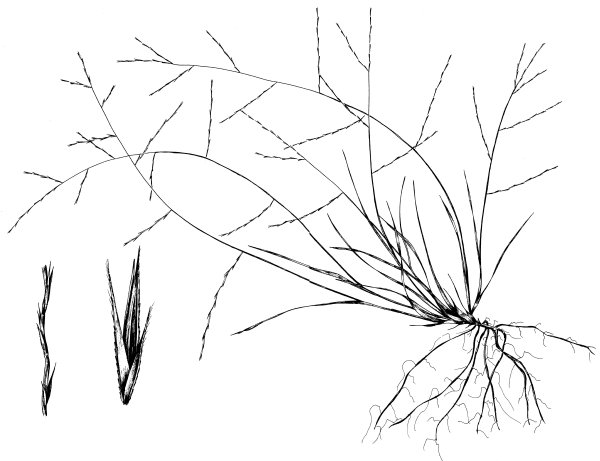
Schedonnardus paniculatus (Nutt.). Tumblegrass Habit: Annual, branched at the base. Culms: 20-40 cm. tall, scabrous, erect or decumbent at base, leaves crowded at the base, at maturity the axis of the plants elongates to over half the length of the plant and the scythe-shaped culm turns downward with the tips of the panicle touching the ground. Finally the panicle breaks away as a tumbleweed. Blades: 2-5 cm. long, 1-2.5 mm. wide, flat, stiff, wavy, smooth, except minutely scabrous on the white margins, spirally twisted when old. Sheaths: Loose, flattened, crowded at the base. Ligule: Membranous, 3 mm. long, decurrent down the margins of the sheath. Inflorescence: Panicle half or more than half the entire height of the plant, its axis usually falcate, rachis hispid, the 3-13 slender spikes solitary and separated 1-5 cm. remote, mostly along the convex side, rigid, and widely spreading, becoming curved in a loose spiral, breaking away at maturity as a tumbleweed. Spikelets: Narrow, acuminate, 3-6 mm. long, sessile and appressed, 1-flowered, alternate on opposite sides of the long, slender, 3-angled rachis, forming several long, slender spikes, rachilla disarticulating above the glumes, not prolonged. Glumes: Narrow, stiff, acuminate, somewhat unequal, hispid on the one nerve, margins scarious, first including the awn 2-4 mm. long (the awn about one fourth of the length), the second 2.56 mm. long (the awn one third its length). Lemmas: Narrow, rigid, acuminate, 3-5 mm. long, longer than the body of the second glume, with 3 green nerves, rounded on the back, minutely hispid on the upper part, slightly pubescent. Palea: Narrow, nearly as long as and enclosed by the lemma. Fruit: Grain free within the subrigid lemma and palea. Habitat: Prairies and plains. July-September. Kansas Range: Throughout. Remarks: The spikelets quite variable.